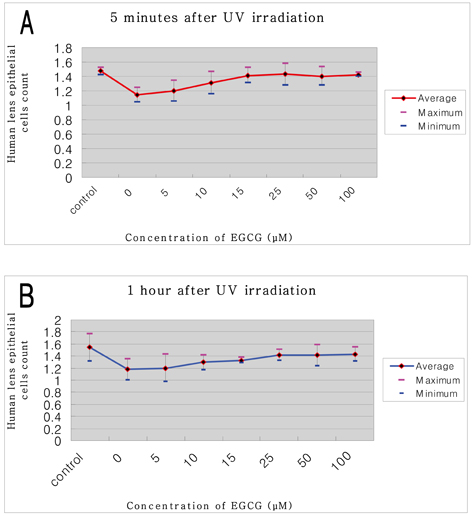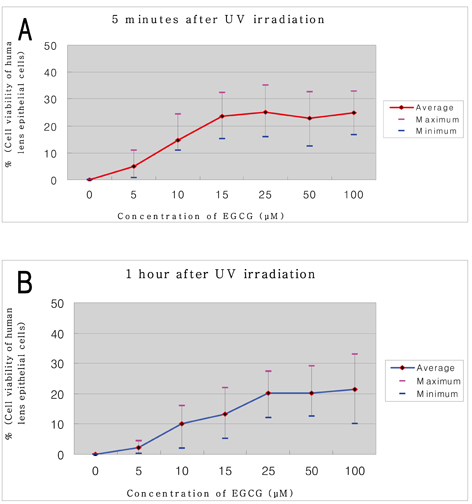Korean J Ophthalmol.
2008 Sep;22(3):183-186. 10.3341/kjo.2008.22.3.183.
Protective Effects of Epigallocatechin Gallate After UV Irradiation of Cultured Human Lens Epithelial Cells
- Affiliations
-
- 1Department of Ophthalmology, Chosun University College of Medicine, Gwangju, Korea. clearcornea@chosun.ac.kr
- 2Department of Biochemistry, Chosun University College of Medicine, Gwangju, Korea.
- KMID: 1070755
- DOI: http://doi.org/10.3341/kjo.2008.22.3.183
Abstract
- PURPOSE: To evaluate the protective effects of epigallocatechin gallate (EGCG) against UV irradiation of cultured human lens epithelial cells. METHODS: We irradiated cultured human lens epithelial cells with a 30-second pulse from a UV lamp with an irradiance of 0.6 mW/cm2. Five minutes and 1 hour after UV irradiation, we administered 0, 5, 10, 15, 25, 50, or 100 uM EGCG. The cell number was measured with a microscopic counting chamber and cell viability was evaluated using the 3-(4,5-dimethylthiazol-2-yl)-2,5-diphenyl tetrazolium bromide (MTT) assay. RESULTS: Compared to untreated cells, the total number of cultured human lens epithelial cells was markedly higher after UV irradiation. In a dose-dependent manner, viability was also higher in EGCG-treated cells. CONCLUSIONS: EGCG increased the cell count and cell viability after UV irradiation of cultured human lens epithelial cells, indicating that EGCG can protect lens epithelium against UV damage.
Keyword
MeSH Terms
-
Antioxidants/*pharmacology
Catechin/*analogs & derivatives/pharmacology
Cell Count
Cell Survival/drug effects
Cells, Cultured
Coloring Agents/diagnostic use
Dose-Response Relationship, Drug
Epithelial Cells/radiation effects
Humans
Lens, Crystalline/cytology/*radiation effects
Radiation Injuries/*prevention & control
Radiation-Protective Agents/*pharmacology
Tetrazolium Salts/diagnostic use
Thiazoles/diagnostic use
*Ultraviolet Rays
Figure
Cited by 1 articles
-
Protective Effect of Catechin on Apoptosis of the Lens Epithelium in Rats with
N -methyl-N -nitrosourea-induced Cataracts
Sung Min Lee, Il-Gyu Ko, Sung-Eun Kim, Dong Hee Kim, Byung Nam Kang
Korean J Ophthalmol. 2010;24(2):101-107. doi: 10.3341/kjo.2010.24.2.101.
Reference
-
1. McCarty CA, Taylor HR. Recent developments in vision research: light damage in cataract. Invest Ophthalmol Vis Sci. 1996. 37:1720–1723.2. Norren DV, Vos JJ. Spectral transmission of the human ocular media. Vision Res. 1974. 14:1237–1244.3. Margrain TH, Boulton M, Marshall J, et al. Do blue light filters confer protection against age-related macular degeneration. Prog Retin Eye Res. 2004. 23:523–531.4. Worgul BV, Merriam GR Jr, Medvedovsky C. Cortical cataract development-an expression of primary damage to the lens epithelium. Lens Eye Toxicity Res. 1989. 6:559–571.5. Taylor HR, West SK, Rosenthal FS, et al. Effect of ultraviolet radiation in cataract formation. N Engl J Med. 1998. 319:1429–1433.6. Zigman S, Vaughan T. Near-ultraviolet light effects on the lenses and retinas of mice. Invest Ophthalmol Vis Sci. 1974. 13:462–465.7. Spector A, Garner WH. Hydrogen peroxide and human cataract. Exp Eye Res. 1981. 33:673–681.8. Ramachandran S, Morris SM, Devamanoharan P, et al. Radio-isotopic determination of hydrogen peroxide in aqueous humor and urine. Exp Eye Res. 1991. 53:503–506.9. Middleton E, Kandaswami C, Theoharides TC. The effects of plant flavonoids on mammalian cells: Implicationsfor inflammation, heart disease and cancer. Pharmacol Rev. 2000. 52:673–751.10. Bettuzzi S, Brausi M, Rizzi F, et al. Chemoprevention of human prostate cancer by oral administration of green tea catechins in volunteers with high-grade prostate intraepithelial neoplasia: a preliminary report from a one-year proof-of-principle study. Cancer Res. 2006. 66:1234–1240.11. Demeule M, Michaud-Levesque J, Annabi B, et al. Green tea catechins as novel antitumor and antiangiogenic compounds. Curr Med Chem Anticancer Agents. 2002. 2:441–463.12. Nagle DG, Ferreira D, Zhou YD. Epigallocatechin-3-gallate (EGCG): Chemical and biomedical perspectives. Phytochemistry. 2006. 67:1849–1855.13. Buttemeyer R, Philipp AW, Schlenzka L, et al. Epigallocatechin gallate can significantly decrease free oxygen radicals in the reperfusion injury in vivo. Transplant Proc. 2003. 35:3116–3120.14. Morley N, Clifford T, Salter LA, et al. The green tea polyphenol (-)-epigallocatechin gallate and green tea can protect human cellular DNA from ultraviolet and visible radiation-induced damage. Photodermatol Photoimmunol Photomed. 2005. 21:15–22.15. Nagai K, Jiang MH, Hada J. (-)-Epigallocatechin gallate protects against NO stress-induced neuronal damage after ischemia by acting as an anti-oxidant. Brain Res. 2002. 956:319–322.16. Xie D, Liu G, Zhu G, et al. (-)-Epigallocatechin-3-gallate protects cultured spiral ganglion cells from H2O2-induced oxidizing damage. Acta Otolaryngol. 2004. 124:464–470.17. Mandel S, Weinreb O, Amit T, Youdim MB. Cell signaling pathways in the neuroprotective actions of the green tea polyphenol (-)-epigallocatechin-3-gallate: implications for neurodegenerative diseases. J Neurochem. 2004. 88:1555–1569.18. Skrzydlewska E, Ostrowska J, Farbiszewski R, Michalak K. Protective effect of green tea against lipid peroxidation in the rat liver, blood serum and the brain. Phytomedicine. 2002. 9:232–238.19. Yokozawa T, Nakagawa T, Kitani K. Antioxidative activity of green tea polyphenol in cholesterol-fed rats. J Agric Food Chem. 2002. 50:3549–3552.20. Negishi H, Xu JW, Ikeda K, et al. Black and green tea polyphenols attenuate blood pressure increases in stroke-prone spontaneously hypertensive rats. J Nutr. 2004. 134:38–42.21. Sutherland BA, Rahman RM, Appleton I. Mechanisms of action of green tea catechins, with a focus on ischemiainduced neurodegeneration. J Nutr Biochem. 2006. 17:291–306.
- Full Text Links
- Actions
-
Cited
- CITED
-
- Close
- Share
- Similar articles
-
- Protective Effects of Epigallocatechin Gallate after UV Irradiation in Cultured Human Retinal Pigment Epithelial Cells
- The Role of Nuclear Factor Kappa B on Lens Epithelial Cells after Ultraviolet B Irradiation
- Green tea polyphenol (–)-epigallocatechin-3-gallate prevents ultraviolet-induced apoptosis in PC12 cells
- The changes of fibronectin in the cultured porcine lens epithelial cells
- The Translocation of Nuclaer Factor Kappa B on Corneal Epithelial Cells after Ultraviolet B Irrradiation




